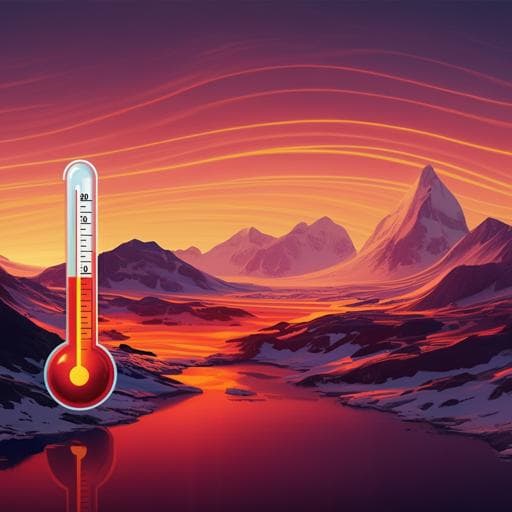
Earth Sciences
Climate warming amplified the 2020 record-breaking heatwave in the Antarctic Peninsula
S. González-herrero, D. Barriopedro, et al.
February 2020 experienced one of the most intense heatwaves in Western Antarctica, with a staggering regional temperature anomaly of +4.5 °C. Researchers Sergi González-Herrero, David Barriopedro, Ricardo M. Trigo, Joan Albert López-Bustins, and Marc Oliva delve into the role of climate change in the unprecedented heatwave, showcasing results that reveal a tenfold increase in the probability of such events since the mid-20th century.
~3 min • Beginner • English
Introduction
Early February 2020 brought one of the strongest recorded heatwaves to the Antarctic Peninsula (AP), with an all-time continental Antarctic temperature record at Esperanza (18.3 °C on 6 February 2020) and widespread extreme warmth from 6–11 February. The event coincided with notable regional ice surface melt. It was associated with a high-pressure system over the Drake Passage advecting warm, moist Pacific air, locally amplified by foehn winds on the AP’s leeward side. While media reports linked the event to climate change, no prior study had quantitatively attributed the specific heatwave to recent climate change. The AP has undergone rapid warming since the 1950s, partly influenced by circulation changes such as the Southern Annular Mode (SAM) and teleconnections (e.g., ENSO), producing substantial variability including a recent cooling hiatus within a long-term warming trend. The study aims to assess, at the event scale and regional (AP-wide) scope, the role of recent climate change in amplifying the 6–11 February 2020 heatwave, using a circulation-analog attribution framework to separate thermodynamic warming from dynamical changes.
Literature Review
Prior work documents rapid AP warming since the mid-20th century, with contributions from large-scale circulation (e.g., strengthened SAM) and tropical/midlatitude teleconnections, and periods of variability including early 21st-century cooling. Studies have examined 2019–2020 seasonal anomalies and site-specific extremes (e.g., Esperanza) and reported record-high surface melt on AP ice shelves during 2019–2020. Event-scale attribution in Antarctica, however, remains scarce. SAM’s trend (linked to GHG increases and ozone depletion) has influenced Antarctic surface climate, but disentangling thermodynamic warming from dynamical drivers is challenging. Previous analyses suggested a background anthropogenic warming persists after removing SAM-congruent trends, and station-based extremes (e.g., Rothera, Halley) show warming trends. Projections indicate more frequent and longer Antarctic warming events under higher greenhouse gas concentrations. This study builds on circulation-analogue methods used in European heatwave attribution to evaluate the AP event.
Methodology
Observations: Station temperatures for the AP were obtained from SYNOP messages; long-term station series (SCAR MET-READER) provided daily mean temperature anomalies relative to the 1950–2019 DJF climatology and were used to validate reanalysis temperature. Monthly 500 hPa geopotential height from AP stations (Bellingshausen, Marambio, Faraday/Vernadsky, Rothera) validated reanalysis Z500.
Reanalysis: ERA5 (1950–2020), using the mean of its 10 ensemble members, provided 3-hourly fields at 0.5° resolution: 2 m temperature (T2m), mean sea level pressure (MSLP), and 500 hPa geopotential height (Z500). Daily means were computed. Validation against SCAR datasets showed generally good performance, with reduced skill in early pre-satellite years; excluding those early years did not affect conclusions.
Analog method: The heatwave window was 6–11 February 2020 when AP [~62–70°S, 76–55°W] T2m anomalies exceeded 3.5 °C. Atmospheric circulation was characterized by daily mean MSLP and Z500 anomalies over a broader Antarctic sector (AN region: 55–78°S, 120–40°W). For each day of the event, historical summer analog days (1950–2019) were identified by low RMSD (<0.9 standard deviations; ~5th percentile) of normalized MSLP/Z500 anomaly fields (latitude-weighted). Circulation-conditioned distributions of AP regional-mean T2m anomalies were reconstructed separately for past (1950–1984) and recent (1985–2019) sub-periods by randomly sampling analog-day AP T2m anomalies N=5,000 times. Sensitivity tests varied thresholds, domains, target fields (e.g., 850 hPa temperature), and definitions of analog pools with similar results.
Accounting for trends: Additional experiments removed summer linear trends in AN MSLP/Z500 and/or AP T2m from the daily fields to isolate thermodynamic vs dynamical contributions. SAM-congruent trends were also removed by regressing detrended summer series on a summer SAM index (defined from zonal-mean MSLP at 40°S and 65°S) and subtracting the SAM-induced component from daily series.
Process attribution: Using the thermodynamic energy equation at 975 hPa, daily AP-mean temperature tendency (Tend) was decomposed into horizontal temperature advection (Adv), adiabatic warming by subsidence (Adiab), and a residual diabatic term (Diab), using ERA5 winds and temperatures (975, 950, 1000 hPa). Contributions were evaluated during the warming/maintenance phase (5–9 February) and across analog days (restricted to Tend>0) to diagnose dominant mechanisms.
Foehn diagnosis: Occurrence of foehn conditions downwind of the AP cordillera was assessed via the mountain Froude number Fr = U_n/(N H), with H≈1000 m, U_n the 975 hPa cross-mountain wind (approximated along NW–SE), and N the Brunt–Väisälä frequency from temperature vertical gradient. Days with Fr ≥ 0.2 were classified as foehn (FE); analog days were partitioned into FE and non-foehn (nFE) to quantify foehn contributions to event magnitude and driving terms.
Key Findings
- Event severity: The AP experienced unprecedented 6-day regional mean warmth during 6–11 Feb 2020, with a mean AP T2m anomaly of +4.5 °C and many local records, including Esperanza’s 18.3 °C (6 Feb). Spatial anomalies reached >8 °C locally and >300 gpm in Z500; the 6-day AP-mean T2m was the highest on record for summer (1950–2020).
- Background trend: AP summer T2m shows a significant warming trend of ~0.2 °C per decade (p<0.001).
- Circulation-conditioned attribution: Under the same large-scale circulation, recent (1985–2019) analogs yield higher AP T2m anomalies than past (1950–1984): means 1.9 °C vs 1.5 °C (difference ~0.4 °C; p<0.001). Warm-end analogs reach 3.3 °C (recent) vs 2.6 °C (past), a 0.7 °C increase over recent decades.
- Probability shift: The probability of a 6-day AP-mean anomaly exceeding 2 °C is now ~10 times higher than in 1950–1984.
- Process contributions: The rapid escalation at event onset (5 Feb) was dominated by warm horizontal advection, with secondary positive diabatic contribution; maintenance (6–9 Feb) was dominated by adiabatic warming (subsidence) with continued warm advection. Over the warming period (5–9 Feb), advection and adiabatic contributions were of comparable magnitude; recent analogs show significant increases in both Adv and Adiab (p<0.001).
- Foehn influence: FE days constituted ~62% of analogs (vs ~25% climatological summer frequency). Foehn conditions added an additional ~0.2 °C (p<0.001) to AP regional mean warming and were associated with enhanced warm advection and adiabatic warming.
- Role of dynamics vs thermodynamics: Analog frequency decreased over 1950–2019 but was not significantly correlated with SAM. Removing SAM-congruent trends had little effect on the warming signal; the event would still be ~0.6 °C warmer now than in the past without SAM changes. Removing AP T2m trend eliminated past–recent differences, indicating thermodynamic (regional mean) warming largely explains the intensification, whereas long-term circulation trends (including SAM) play a minor role.
Discussion
The study addresses whether recent climate change amplified the February 2020 AP heatwave. By conditioning on observed circulation, the analog framework shows that similar atmospheric patterns in recent decades would have produced significantly warmer outcomes than in the mid-20th century. The event’s rapid onset reflects strong warm advection into the AP, with subsequent persistence driven by subsidence under a quasi-stationary high-pressure system; foehn winds further enhanced eastern AP temperatures. The pronounced increase in magnitude (≥0.4 °C; ~25%) and the tenfold rise in the probability of intense 6-day anomalies (>2 °C) demonstrate a clear thermodynamic fingerprint consistent with the long-term AP summer warming. Analyses indicate only limited contributions from SAM-related or broader dynamical trends; removing SAM effects slightly strengthens the thermodynamic signal. Thus, the findings link the heightened severity of 2020-like AP heatwaves primarily to background warming, consistent with prior attributions of AP mean warming to anthropogenic forcing and projections of more frequent/severe Antarctic heatwaves under increased greenhouse gases.
Conclusion
This work provides the first AP-wide, event-scale attribution of the February 2020 heatwave, demonstrating that recent climate warming substantially increased its magnitude and likelihood. Using circulation analogs, the study quantifies a ≥0.4 °C amplification (~25% of event magnitude) and a ~10-fold increase in the probability of strong multi-day regional anomalies, primarily due to thermodynamic warming rather than changes in atmospheric circulation. Mechanistically, warm advection and subsidence dominated the event, with foehn winds adding regional warming. The results support a strong climate change signal at the event scale in Antarctica and imply growing risks of extreme heat and melt episodes in the AP under continued warming. Future research should leverage multiple datasets, alternative attribution methodologies, and climate models to better isolate anthropogenic contributions, explore specific physical feedbacks (e.g., moisture, albedo, sea-ice interactions), and assess implications for cryosphere stability.
Limitations
- Analog method constraints: limited pool of good analogs given short seasonal windows; uncertainties in time-evolving extreme probabilities inherent to circulation-analogue approaches; inability to partition the overall climate change signal into specific anthropogenic drivers (e.g., GHG vs ozone) without model-based counterfactuals.
- Data limitations: ERA5 performance is reduced in early pre-satellite years; observational records in the AP are relatively short and spatially sparse; large interannual–decadal variability complicates attribution.
- Dynamical complexity: Multiple interacting drivers (SAM, Amundsen Sea Low, ENSO, sea-ice variability) limit precise process attribution; foehn diagnosis via bulk Fr threshold may miss local nuances.
- Residual terms: Diabatic contribution estimated as residual in the thermodynamic budget may include unresolved processes and numerical errors.
These limitations may affect precise quantification but do not alter the qualitative conclusion that thermodynamic warming has amplified 2020-like AP heatwaves.
Related Publications
Explore these studies to deepen your understanding of the subject.







